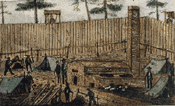 |
Confederate P.O.W. Camps |
|
State War Records |
| AL - AK - AZ - AR - CA - CO - CT - DE - FL - GA - HI - ID - IL - IN - IA - KS - KY - LA - MA - MD - ME - MI - MN - MS - MO - MT - NE - NV - NH - NJ - NM - NY - NC - ND - OH - OK - OR - PA - RI - SC - SD - TN - TX - UT - VT - VA - WA - WV - WI - WY |
Danville Prisoner of War Camp
Search, View, Print Union & Confederate Civil War Prisoner of War Records, 1861-1865

Confederate 1863-1865
Danville, Virginia
Because of continued supply problems and overcrowding of the city's prisons, Gen. Robert E. Lee suggested the use of Danville as another place to hold prisoners. It had good railroad connections, availability of wood, cheaper abundance of provisions, was a safe distance from Union attack, and a short distance to City Point. Before Danville became a prison, several of the prison's warehouses had been converted into military hospitals.
The town of Danville was symbolic of antebellum southern culture. The town was located at the extreme south-central part of Virginia, 143 miles southwest of Richmond and 4 miles north of the North Carolina border.
By November 11, 1863, arrangements were made to transfer 4,000 prisoners to the prison. On November 17, Capt. Turner, a contingent of guards, and the prisoners arrived at Danville.
The prison consisted of 6 vacant brick buildings, mostly tobacco and cotton warehouses in the center of town. One of the buildings, a 3-story structure with an estimated capacity of 700, had an attached bakehouse and cooking range with the capability of preparing rations for 3,000 men. Opposite this building was a large frame house with a large room to be used as the commandant's headquarters, as well as workshops for garrison use. There were 3 other warehouses, all within 100 yards of each other, that had a combined estimated capacity of 2,300 prisoners. Not far away, 2 additional buildings came into use. Both of them were located within the town's business district. The combined capacity of these 2 buildings was almost 1,300.
For the most part, these buildings, overlooking the Dan River that ran through the center of town, were similar to the warehouses used at Richmond. They were 3 stories with attics, bare of furniture, with rows of large wooden support posts running down the middle. each floor was a wide-open area of about 2,400 square feet. Prisoners were confined only on the upper 2 floors, while the lower floor was heavily patrolled by the guards. Wooden staircases along the inside walls connected the floors.
The buildings were designated as Prisons No. 1- 6. The largest was Prison No. 1, and included the bakehouse addition. Prisons No. 2 through No. 4 were warehouses owned by J.W. and C.G. Holland. Prison No. 5 was situated at Floyd and High streets, a few blocks away. The Dibrell Brothers Tobacco Warehouse, a large portentous structure, with 2 ornamental turrents on the front, was designated as Prison No. 6.
Although Danville became known as a prison for Union officers, enlisted men were also included initially, and Prison No. 6 was used for the confinement of black prisoners.
The first commandant was Maj. Mason Morfit. Another commandant was Lt. Col. Robert C. Smith. The prisoners regarded Smith, as "a kind, sympathetic man" who "would not voluntarily inflict any unnecessary hardships upon those under his charge." As in most Southern prisons, however, the guards and the commandant could do little to alleviate the horrid conditions.
LIFE & CONDITIONS:
Inmate Maj. Abner Small of the 16th Maine Volunteer Regiment reported that crowded conditions and boredom were the worst problems at Danville Prison No.3:
"Our quarters were so crowded that none of us had more space to himself than he actually occupied, usually a strip of the bare hard floor, about six feet by two. We lay in long rows, two rows of men with their heads to the side walls and two with their heads together along the center of the room, leaving narrow aisles between the rows of feet...I remember three officers, one a Yankee from Vermont, one an Irishman from New York, and a Dutchman from Ohio, who messed together by the wall opposite me. When they came to Danville they were distinct in feature and personality. They became homesick and disheartened. They lost all interest in everything, and would sit in the same attitude hour after hour and day after day....It grew upon me that they were gradually being merged into one man with three bodies. They looked just alike; truly I couldn't tell them apart. And they were dying of nostalgia."
Black prisoners suffered the greatest of all. Most of them died while in the prison.
Within a few weeks after opening, the prison became overcrowded. An average of 650 prisoners were confined on each floor of each building. The space allotted to each man amounted to almost 4 square feet, just enough to lie down in. At the end of each floor was an old-fashioned stove fitted out for burning wood. The wood was brought in from a woodpile in the prison yard and always under heavy guard. From the beginning, rations included black bread made from ground sorghum cane and coffee made from burnt rye. Usually included with this was about 2 ounces of beef, a little soup, and some rice. later on, the ration decreased to the point where the ration was nothing more than 1.5 pounds of cornbread per man.
Death from disease was increasing rapidly. Smallpox broke out in the Richmond prisons shortly before the transfer of prisoners and apparently was carried to the Danville prison. The disease continued to spread throughout the prison buildings, among the guards, and into town. The prison guards became notorious for conning the prisoners out of their blankets.
By the end of January 1864, there were still 4,000 prisoners. A smallpox epidemic raged through the prison, business district, and the town. Parasites were another big problem at the prison.
Security was tightened because of several escape attempts. Afterward, the prisoners were no longer allowed access to the ground levels or yards of the buildings. Prisoners were even escorted to go to the latrine. They were under heavy guard and only 6 prisoners could go at a time. They were not allowed at the windows for any reason.
By late summer, the smallpox subsided and chronic diarrhea became the prevalent cause of death. Burials were conducted on land about 1.5 miles outside of town.
In February 1864, the residents of Danville wrote to Secretary of War James A. Seddon to "petition for the removal of the Yankee prisoners located among us to some other place...because the hospitals of the prisoners and sick are located in the very heart of the town...so as to infect the whole atmosphere of the town with smallpox and fever now raging within the limits of the corporation."
By late October 1864, a few thousand prisoners were sent from Belle Isle prison to Danville.
By January 1865, daily rations were down to nothing more than cornbread.
